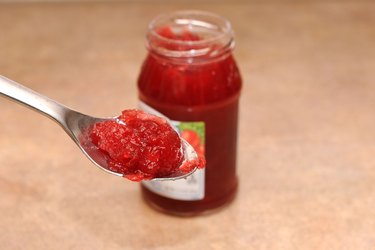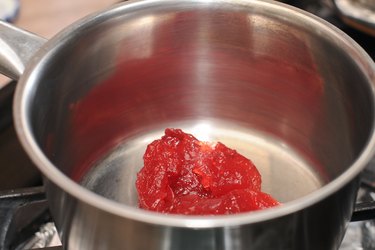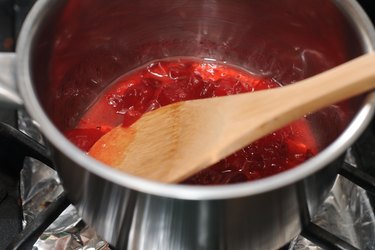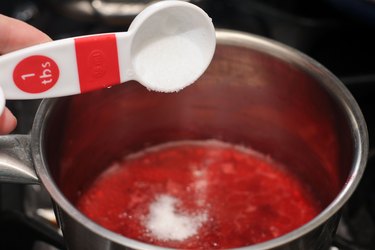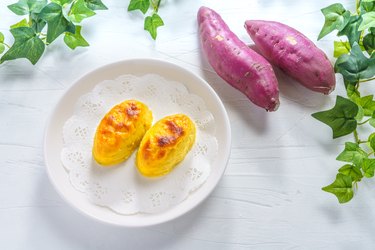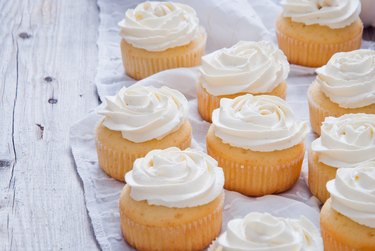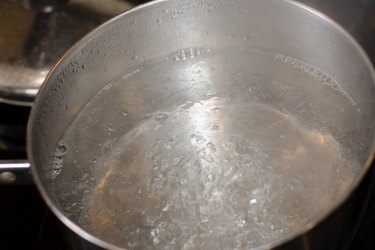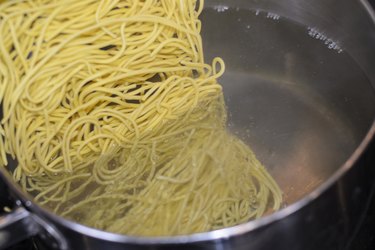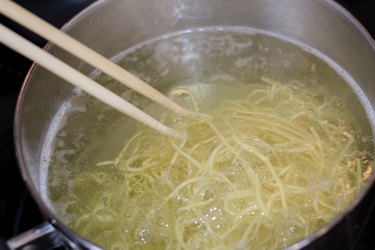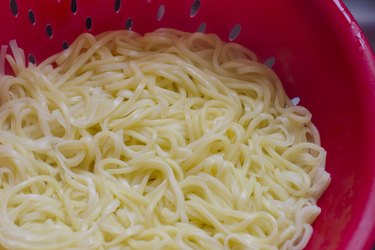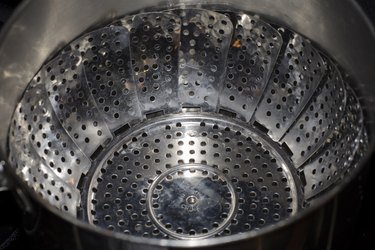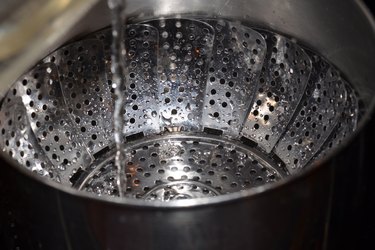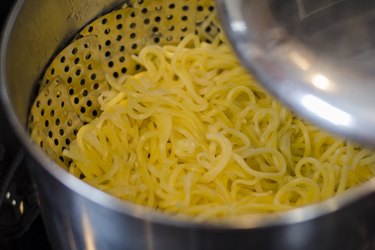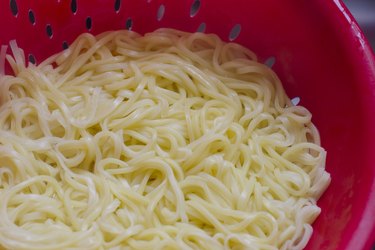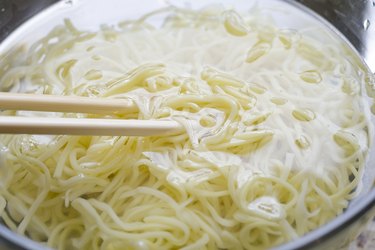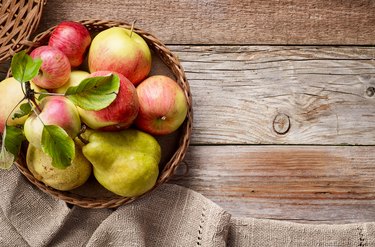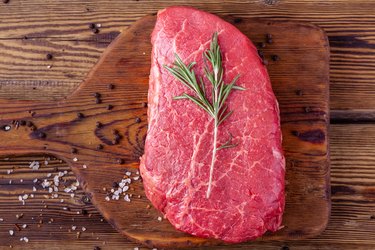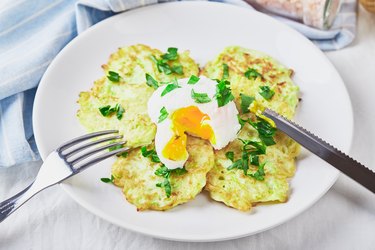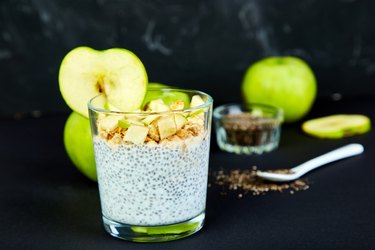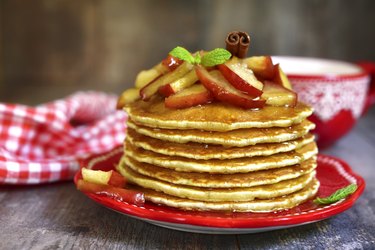Japanese sweet potatoes have sweeter-tasting and softer flesh than most yams.
Image Credit:
Wako Megumi/iStock/GettyImages
Japanese sweet potatoes, with their reddish-purple skin, are an alternative to the traditional sweet potato. Naturally low in fat and high in nutritional value, they are packed with health benefits. The sweet tuber is rich in antioxidants as well as heart-healthy minerals. In addition, the nutrients in Japanese sweet potatoes may help you lose weight, banish depression, improve your vision and control glucose levels.
About Japanese Sweet Potatoes
Japanese sweet potatoes are also known as Satsuma-imo. They are botanically classified as Ipomoea batatas (from morning glory family), which includes many different varieties of sweet potatoes grown in Japan.
Small to medium in size, Japanese sweet potatoes are long, slender and irregularly shaped tubers. The semi-rough, textured skin is garnet-colored with a distinct purplish undertone. Once cooked, the mildly sweet-flavored soft flesh deepens to a golden, cream-colored hue with a dry, starchy texture.
Yams vs. Japanese Sweet Potatoes
Japanese sweet potatoes, also called a Japanese yam, are quite similar to American yams but possess a sweeter taste and softer flesh with a lighter yellow coloring. However, all varieties of sweet potatoes belong to the morning glory family, while yams are tubers related to lilies native to Africa and Asia, says Harvard T.H. Chan School of Public Health.
All varieties of sweet potatoes contain similar nutritional profiles but, depending on their color, some have a higher phenolic and carotenoid content. Yellow and orange sweet potatoes have a higher content than the purple and white ones.
Japanese Sweet Potato Calories
Japanese sweet potatoes provide 264 calories per 200 grams, which is the equivalent of one medium potato. Of the total calories in a sweet potato, 9.6 calories comes from protein, which is 2.4 grams. You need protein to build tissue including bones, muscles and skin.
The USDA recommends that 10 to 30 percent of your calories should consist of protein, which amounts to about 56 grams for men and 46 grams for women per day.
Japanese sweet potatoes contain only an insignificant amount of fat and no cholesterol. Of course, if you eat your baked potato with butter or sour cream, you will increase the fat content. Try using herbs or spices and a dollop of yogurt to add flavor instead.
Carbs in Sweet Potato for Energy
About 95 percent of the calories in Japanese sweet potatoes come primarily from healthy complex carbohydrates. Carbs are important for the production of energy needed for metabolic and physical processes. Carbs help fuel your brain, nervous system, cells and heart.
The USDA recommends that your intake of carbs be 45 to 65 percent of your daily caloric intake. Eating a Japanese sweet potato provides 63 grams or about 20 percent of your daily value.
One Japanese sweet potato offers 4.6 grams of dietary fiber, which is the front-runner for keeping your digestive system healthy. Fiber is the part of food your body cannot digest. By absorbing water and adding bulk to increase the size and soften your stool, fiber helps prevent constipation, hemorrhoids, irritable bowel syndrome, diverticulitis and other gastrointestinal disorders.
A high-fiber diet may also be beneficial in reducing the risk of heart disease, obesity and diabetes, says the Mayo Clinic. In addition, conclusions from a 2019 study published in the International Journal of Food Sciences and Nutrition, found fiber in the diet reduced the incidence of colorectal cancer, perhaps from its role in increasing the weight of the stool.
USDA Dietary Guidelines say you should consume between 22.4 and 33.6 grams of fiber daily, depending on your gender and age.
High Content of Healthy Vitamins
Japanese sweet potatoes contain most of the B vitamins that your body needs for energy production and to maintain the proper functioning of your brain and nervous system. Each 200-gram medium potato contains the following B vitamins:
Sweet potatoes help your immune system with their antioxidant capacity. Each Japanese sweet potato contains two potent antioxidants that neutralize potentially damaging oxidizing agents in your body and help reduce disease. These are:
Good Source of Essential Minerals
Japanese sweet potatoes are rich in healthy minerals, especially potassium, copper and manganese. The amounts, per potato, are as follows:
Minerals for Cardiovascular Health
Some important nutrients in Japanese sweet potato benefit your heart and may help to reduce your risk of cardiovascular disease. The National Institutes of Health suggests that eating a vegetarian diet high in calcium, magnesium, potassium and fiber, and low in fat, such as Japanese sweet potatoes, may result in lower blood pressure.
Potassium to Protect Your Heart
The potassium content in Japanese sweet potato helps to maintain the fluid and electrolyte balance and cell integrity in your body. Potassium is also needed for the development and maintenance of your nervous system and muscles, including your heart.
By regulating the relaxation of the walls of your blood vessels, potassium helps to lower or maintain your blood pressure. Harvard Health Publishing says potassium manages the conduction and transmission of electrical signals in your nervous system, which protects against irregular heartbeat.
Calcium to Maintain Cholesterol
Calcium in Japanese sweet potato is another mineral that helps reduce heart disease by decreasing the absorption of fat and lowering cholesterol levels. A deficiency of calcium may cause abnormal heart rhythms, warns the National Institutes of Health.
Magnesium to Help Blood Pressure
Magnesium in Japanese sweet potato helps regulate blood pressure and blood sugar as well as maintain muscle and nerve function. Your blood vessels need magnesium to relax and to transport calcium and potassium. The combination of the three minerals contributes to lessening your chance of developing hypertension.
Eating a sweet potato might help you chase away the blues. One of the important amino acids that make up the protein in Japanese sweet potatoes is a compound called tryptophan. Japanese sweet potato contains 30 milligrams of tryptophan.
Tryptophan is the precursor of both serotonin and melatonin. Serotonin is a brain neurotransmitter that regulates mood, sleep, appetite and pain. You will often find serotonin included as an ingredient in antidepressants. Melatonin in sweet potatoes has been shown to promote sleep and is used in sleep-aid medications.
A 2016 study examined the association of various levels of tryptophan on emotion and cognitive reaction. Findings, published in Nutrients, showed that low levels of serotonin in the brain are linked to impaired memory and depressed mood.
Japanese sweet potatoes, like all sweet potatoes, are a good source of beta carotene that your body converts to vitamin A. Vitamin A is known to help prevent dry eyes and night blindness. Vitamin A also helps reduce the risk of eye infections.
Sweet potatoes have a high content of zeaxanthin along with its isomer lutein. These fat-soluble antioxidant carotenoids. located in the retina of your eye, have been shown to prevent or delay the progression of chronic eye diseases such as age related macular degeneration and cataracts, according to American Optometric Association.
Vitamin E in Japanese sweet potatoes is also good for the health of your eyes and may reduce the risk of cataracts, according to a meta-analysis, published in Public Health Nutrition in 2015.
Choosing low-glycemic foods such as Japanese sweet potatoes, may help prevent obesity and chronic disease. The glycemic index (GI) rates how carbohydrate-based food raises blood glucose levels. Foods with a low-GI value (under 55) are slowly digested and absorbed, causing a slower and smaller rise in blood sugar levels.
Blood sugar spikes can cause your blood vessels to harden and narrow, which can lead to damage to your heart. Controlling blood glucose can help prevent and delay the onset of complications, including heart disease, stroke and damage to your nerves and kidneys, advises the American Diabetes Association.
GI Depends on Preparation Methods
The glycemic index of sweet potato depends on the cooking method. The more cooking and processing the potato goes through, the higher the glycemic index. The GI of a peeled sweet potato, boiled, is low at 46. But a baked sweet potato has a GI of 94.
This is because, when subjected to the high heat of baking or frying, starches break down into sugars instead of remaining in a more complex form.
When you boil potatoes the temperature cannot go above the boiling point of water or 212 F. Baking is typically done at 350 F, which breaks down the starches more completely, making them easier to digest.
Good Food for People With Diabetes
Foods low on the GI index, such as boiled sweet potatoes, have a place in a healthy diet for people with diabetes. This is evidenced in a 2018 systematic review that analyzed the effect of glycemic diets in patients with Type 2 diabetes.
The findings, published in Nutrients, reported that low-GI diets are more effective in controlling fasting blood glucose levels compared with a higher-GI diet for people with diabetes.
In addition to being fat-free with a low GI rating, the high content of dietary fiber in Japanese sweet potatoes may help you stay on your weight-loss plan. Fiber is filling, without adding significant calories. This feeling of fullness is satiating and may help you control your intake of food and prevent overeating.
With the high-carb content of Japanese sweet potatoes you might think they would cause you to gain weight. However, a 2018 meta-analyses of clinical trials showed diets containing foods high in carbohydrates and fiber, but with a low glycemic index, and low in fat are associated with weight loss and a decrease in body composition.
In the trial, people with overweight were given a plant-based high-carb, low-fat, low GI diet. Results, published in the journal Nutrients, found the study group had overall loss of body weight and body fat after 16 weeks. In addition, there was a decrease in insulin resistance. This effect was without adding any exercise.
